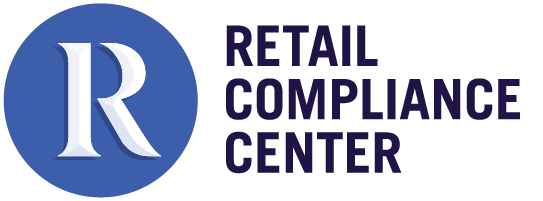Hazardous Materials Transportation
This section covers the transportation of items that are considered hazardous materials. This includes the federal and international regulations that regulate these goods, how to recognize hazardous materials, and the key responsibilities for retailers.
Lithium batteries are becoming an increasingly common category of hazardous materials for retailers. The RCC Lithium Batteries FAQ has more information on shipping these batteries.
Lithium Batteries Fact Sheet
A fact sheet detailing regulations on transporting lithium batteries and the safety hazards of transporting lithium batteries.
View Fact SheetCOMPLIANCE CONSIDERATIONS
What Are Hazardous Materials?
Hazardous materials are materials with the potential for health, safety, or environmental hazards during transportation in commerce. A wide variety of consumer products and other chemicals that are routinely distributed and sold by retailers may be hazardous materials, including:
- Fireworks, flares, toy rockets
- Aerosols
- Fire extinguishers
- Nail polish remover
- Perfumes
- Lighter fluid
- Oil-based Paint, paint thinner
- Batteries
- Ammunition
- Pool chemicals
- Garden care products
- Cleaning products
Who Do Hazardous Materials Rules Apply To?
Hazardous Materials rules apply to anyone who offers hazardous materials to a carrier for transportation or anyone who transports hazardous materials in commerce.
Retailers who send hazardous materials from distribution centers to stores, who ship hazardous materials directly to customers, or who send hazardous materials in reverse logistics are hazardous materials shippers. In addition, retailers who send hazardous materials using their own transportation fleet are also hazardous materials carriers.
Which Rules Apply to Hazardous Materials Transportation?
The Pipeline and Hazardous Materials Safety Administration (PHMSA) within the U.S. Department of Transportation has established rules for how hazardous materials must be transported by road, rail, air and water. These rules are commonly known as the Hazardous Materials Regulations or the HMR.
Common carriers, such as overnight delivery services or the U.S. Postal Service, impose additional restrictions on hazardous materials. For example, some overnight carriers require compliance with international air regulations, such as the International Air Transport Association (IATA) Dangerous Goods Regulations, which incoporate the International Civil Aviation Organization (ICAO) details established at the United Nations (UN) level. It is important to check with your carrier to make sure you are complying with their requirements for shipping hazardous materials.
Imports from overseas are generally subject to international rules, such as the IATA Dangerous Goods Regulations, if imported by air, or the International Maritime Dangerous Goods Code, if imported by sea. Under some circumstances, shippers may use either Canada’s Transportation of Dangerous Goods Regulations or the HMR for transportation by motor vehicle or rail from the United States to Canada, or from Canada to the United States. Transportation to or from Mexico generally must be in accordance with the hazardous materials rules of each respective country (i.e., the HMR for the portion of the journey in the United States).
The federal PHMSA regulations preempt state hazardous materials transportation, regulations that are in conflicy with the HMR, although states may in some cases impose additional requirements as long as they are not inconsistent with federal requirements. For example, some states require licenses for transporting hazardous materials, in addition to federal requirements.
Requirements for transporting hazardous materials vary based on the type of hazardous material, the quantity being transported, the manner of packaging, the mode of transportation (e.g., air or ground), and the transport route (e.g., domestic or international).
How Do I Recognize Hazardous Materials?
Hazardous materials are materials listed in an HMR table in 49 C.F.R. 172.101 and any other material that meets the criteria set forth in 49 C.F.R. Part 173 for one or more of the following hazard classes:
- Class 1 -- Explosives
- Class 2 -- Gases
- Division 2.1 -- Flammable gas
- Division 2.2 – Non-flammable, nonpoisonous compressed gas, including compressed gas, liquefied gas, pressurized cryogenic gas, compressed gas in solution, asphyxiant gas, and oxidizing gas
- Division 2.3 -- Gas poisonous by inhalation
- Class 3 -- Flammable liquid/combustible liquid
- Class 4:
- Division 4.1 -- Flammable solid
- Division 4.2 -- Spontaneously combustible material
- Division 4.3 -- Dangerous when wet
- Class 5:
- Division 5.1 -- Oxidizer
- Division 5.2 -- Organic peroxide
- Class 6:
- Division 6.1 -- Poisonous material
- Division 6.2 -- Infectious substance
- Class 7 -- Radioactive material
- Class 8 -- Corrosive material
- Class 9 -- Miscellaneous hazardous material
Information about a product's hazardous materials classification may be in the Safety Data Sheet or may be obtained from the manufacturer.
Hazardous materials also include hazardous substances, marine pollutants, as specified in the HMR and some wastes including:
- Hazardous wastes requiring a hazardous waste manifest under federal Resource Conservation and Recovery Act (RCRA) rules
- Infectious medical waste
- Any other waste that meets the HMR criteria for a hazardous material
What Are My Responsibilities?
Anyone who offers hazardous materials to a carrier or anyone who transports hazardous materials in commerce must comply with detailed requirements for the specific hazardous material and the mode of transportation, including:
- Classification of hazardous materials
- Employee training
- Identifying a proper shipping name
- Packaging
- Labeling, marking & placarding
- Shipping papers & emergency response information
- Security plans
- Loading/unloading
- Recordkeeping
- Registration
- Incident Reporting
- Oversight of logistics contractors
Are There Any Exceptions?
Numerous exceptions may be available, depending on the type of material, quantity, packaging, and mode of transport. Exceptions typically provide only limited relief or impose different requirements. As of January 1, 2021, the Other Regulated Materials - Domestic (ORM-D) marking has been phased out and may no longer be used for Consumer Commodities. Consumer Commodities, as defined in 49 C.F.R. Section 171.8, that were previously labeled ORM-D must now be repackaged and relabeled, unless they meet one of the exceptions below. Some potentially relevant exceptions for retailers include:
Hazardous Materials in Limited Quantities
Many types of products are eligible for these exceptions. These are hazardous materials of low or medium danger (as identified in the HMR) in small primary containers and packaged for transport in strong outer packaging not exceeding certain maximum weights. Limited Quantities must comply with reduced requirements, but in many cases are excepted from shipping papers and hazard labeling. Packages must bear the mark for Limited Quantity.
Materials of Trade
Hazardous materials transported by retailers may be eligible in some cases (e.g., when the retailer is offering appliance repair or other in-home services) for the materials of trade exception. These are hazardous materials, other than hazardous wastes, that are transported by motor vehicle for one of three purposes: (1) protecting health and safety of the motor vehicle operator or passengers; (2) supporting the operation or maintenance of a motor vehicle or its auxiliary equipment; or (3) by a private motor carrier, including vehicles operated by a rail carrier, in direct support of a principal business function other than transportation by motor vehicle. Only certain types of hazardous materials are eligible for this exception, and weight limits, marking, and driver notification requirements apply.
Additional Quantity Exemptions
Reduced requirements are also available when certain types of hazardous materials are transported in very small amounts.
Different requirements apply to each of these exceptions.
Reverse Logistics
Reduced requirements for employee training are available for transport of Limited Quantities of certain hazardous materials, other than hazardous wastes, in reverse logistics. To be eligible, the hazardous materials must be transported by motor vehicle from a retail store for return to a manufacturer, supplier, or distribution facility for purposes of recycling, obtaining manufacturer's credit, recall, replacement or similar reasons.
Material Specific Exceptions
Some hazardous materials are eligible for reduced requirements based on their characteristics, quantity, or mode of transportation. Materials for which reduced requirements may apply include combustible liquids, certain types of batteries, and bulbs containing hazardous materials.
Special Permits and Approvals
PHMSA may provide a case-by-case exception in the form of a Special Permit or Approval if it can be shown that an equivalent level of safety can be achieved by following alternative procedures for shipping a particular hazardous material.
This list of exceptions is not exhaustive, and the availability of a particular exception may vary depending on the hazardous material and the particular circumstances.
Tags
-
Hazardous Waste
-
Haz Mat Transportation
-
Hazardous Waste Overview



